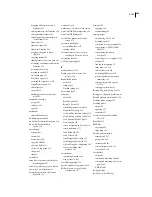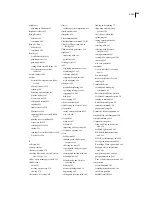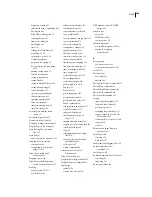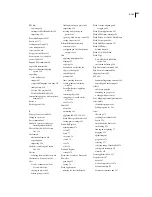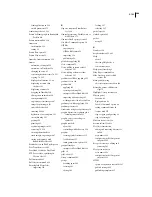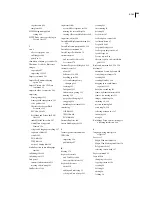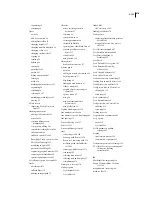
FLASH CS3
User Guide
499
function func()
{
// Create the Date object.
var funcDateObject = new Date();
// Returns the current date as a string.
trace(funcDateObject);
// Delete has no effect.
delete funcDateObject;
// Still returns the current date.
trace(funcDateObject);
// Set the object reference to null.
funcDateObject = null;
// Returns null.
trace(funcDateObject);
}
// Call func() function.
func();
Loading data for mobile devices in Flash Lite
When developing files for mobile devices, minimize the amount of data you attempt to load at one time. If you are
loading external data into a Flash Lite file (for example, using
XML.load
), the device’s operating system may generate
a “memory failure” error if insufficient memory is allocated for the incoming data. This situation can occur even if
the total amount of remaining memory is sufficient.
For example, suppose a file attempts to load an XML file that’s 100 KB, but the device’s operating system has allocated
only 30 KB to handle that incoming data stream. In this case, Flash Lite displays an error message to the user,
indicating that not enough memory is available.
To load large amounts of data, group the data in smaller pieces—for example, in several XML files—and make several
data-loading calls for each piece. The size of each piece of data, and therefore the number of data-loading calls you
need to make, varies by device and file. To determine an appropriate balance between the number of data requests
and the likelihood of a memory failure, test files on a variety of target devices.
For optimum performance, avoid loading and parsing XML files if possible. Instead, store data in simple name/value
pairs and load the data from a text file using
loadVars
or from precompiled SWF files.
Exclude classes from compilation for Flash Lite
To reduce the size of a SWF file, consider excluding classes from compilation but retaining the ability to access and
use them for type checking. For example, try this if you are developing a file that uses multiple SWF files or shared
libraries, especially those that access many of the same classes. Excluding classes helps avoid duplicating classes in
those files.
1
Create a new XML file.
2
Name the XML file FLA_filename_exclude.xml, where FLA_filename is the name of the FLA file without the .fla
extension. For example, if the FLA file is sellStocks.fla, the XML filename must be sellStocks_exclude.xml.
3
Save the file in the same directory as the FLA file.
4
Place the following tags in the XML file:
excludeAssets>)
<asset name=”className1” />)
<asset name=”className2” />
</excludeAssets>



















